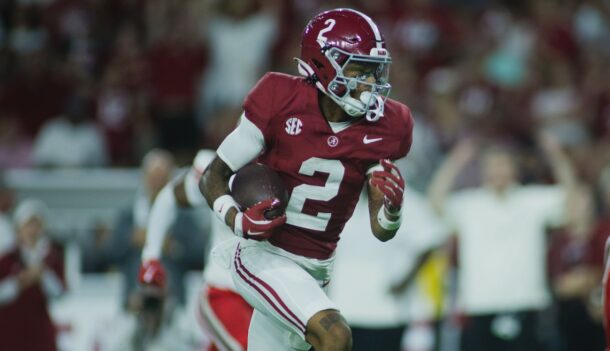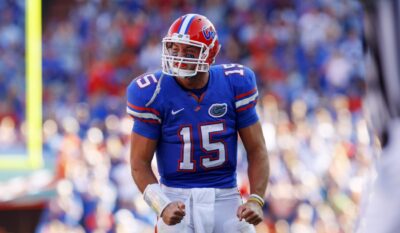Dak Prescott is SEC’s brightest star entering spring practice
By Ethan Levine
Published:
A number of superstar talents are back for more in the SEC in 2015, but none shined brighter last season than Mississippi State quarterback Dak Prescott.
The Bulldogs signal caller threw for more than 3,400 yards last fall — ranking 18th in the nation in yards through the air — and his 986 rushing yards took him over the 800-yard plateau for the second year in a row. Not to mention he won 10 games at a school that had only achieved the feat once in a 70-year span prior to 2014, and finished eighth in Heisman voting despite having just seven career starts to his name at the beginning of the year.
But 2014 is now a thing of the past, solidified as nothing more than another chapter of the college football history books. Prescott’s sensational season is now just a legend that will be passed down through generations of Mississippi State faithful in the coming years and decades (and believe me, his season holds that kind of historical significance for the school).
The question Prescott and the Bulldogs now face is simple: What can Prescott do to improve on his 2014 performance this coming fall, and how can he make those improvements a reality?
The journey to answering that question begins with spring practice, which opens in Starkville next month. That string of practices, culminating with the annual spring game in April, will not only allow Prescott to improve as an individual, but will also allow him to take command of an offense losing a number of key pieces from last season.
SELF-IMPROVEMENT
As sensational as Prescott was in 2014, he showed some obvious flaws in his game late in the season when MSU dropped three of its final four contests.
As a team, Mississippi State only ran for fewer than 200 yards once during its 9-0 start, and the one game it fell short of the 200-yard plateau it barely beat an Arkansas team that had yet to win a conference game to that point in the season. Not coincidentally, Prescott completed at least 60 percent of his passes in eight of those first nine games as a complement to the run game.
However, the Bulldogs only ran for 200 yards once in its 1-3 finish to the year, and Prescott only completed at least 60 percent of his passes twice in that span.
The pattern isn’t tough to uncover. When Mississippi State ran the ball effectively, Prescott was able to make the right throws at the right time to open pass catchers. But when the Bulldogs couldn’t run the ball well and defenses weren’t dared to load the box to slow down the rushing attack, Prescott struggled to stand in the pocket, go through progressions and make an accurate, timely throw against pressure or complex coverages.
Mississippi State lost starting tailback Josh Robinson to the NFL after he finished in the top 5 in the SEC in yards and touchdowns last season. Although Dan Mullen’s offense has turned every MSU featured back into a 1,000-yard rusher during their time in Starkville, Prescott must enter the season assuming the run game will regress at least a marginal amount.
Thus, Prescott must put in work with Mullen and the coaching staff in the film room this spring to really progress as a passer. He needs to become a smarter quarterback, not just a tremendous athlete with a big frame, strong arm and swift feet.
If Dak can improve himself in the cerebral areas of the game — learning how to read coverages before the snap, how to change protections himself without veteran center Dillon Day anchoring the offensive line and how to throw receivers open rather than waiting for them to free themselves to throw the ball — he could earn himself a trip to New York as a Heisman finalist.
He may throw more interceptions as a result of taking on these added responsibilities within the offense, but the unit as a whole will improve against the SEC’s toughest competition as a result. Florida State quarterback Jameis Winston threw 18 interceptions last season, but still led his team to a 13-1 record, an ACC title and a playoff berth. And now that he’s preparing for the NFL Draft, he’s seen as a better pure quarterback than Oregon quarterback and Heisman winner Marcus Mariota, who threw fewer picks playing in a much simpler passing scheme.
Ultimately, Prescott has all the physical tools to be a great quarterback, and if he can improve his game in pre-snap situations beginning this spring he could be even more dangerous next season.
TEAM IMPROVEMENT
The Bulldogs lost key starters at almost every position after last season, but luckily for Prescott the one position where MSU returns a majority of its talent is wide receiver.
Mississippi State bid farewell to starting wideout Jameon Lewis, who caught 32 passes for 380 yards and a pair of touchdowns last season, and starting tight end Malcolm Johnson, who made 28 catches for 380 yards and three touchdowns in 2014.
Other than that pair of pass catchers, both of whom were contributors but neither of whom were stars, Mississippi State brings back the rest of its top receivers from last season, including top option De’Runnya Wilson.
So it will be just as vital for Prescott to maintain and even improve upon the rapport he shares with those wideouts, namely Wilson, during the spring practice season. The best quarterbacks are so in-sync with their receivers that they can throw blindly to a spot knowing in their brains how long it will take a wideout to get to a certain spot.
Granted, opposing defenses and other variables presented by live game situations will alter that timing somewhat, but having a feel for what every target is doing on a given play while only being able to keep an eye on one at a time can only serve to improve Prescott’s play.
Fred Ross, MSU’s No. 2 wideout last season, caught 24 of his 30 passes in the Bulldogs final seven games, showing he and Prescott began developing a similar connection as the 2014 campaign wore on. The same can be said for Joe Morrow, another emerging threat on the outside who caught 11 of his 17 passes on the year in the Dawgs final three games.
Now that those two are poised to take on bigger roles with added experience and the losses of Lewis and Johnson, continuing to grow those relationships within the offense will be crucial for Prescott this spring.
The addition of four-star junior college transfer Donald Gray will add depth at the position, and the fact that he’s already been tested at the JUCO level should allow him to make an impact right away. Even better, he’s one of six early enrollees from MSU’s 2015 recruiting class, which means he and Prescott can develop some timing this spring before the season arrives.
The reigning first-team All-SEC quarterback is already established as one of the nation’s top returning signal callers, but he still has plenty to work on this spring both on and off the field if he’s to lead Mississippi State through another 10-win season.
A former newspaper reporter who has roamed the southeastern United States for years covering football and eating way too many barbecue ribs, if there is such a thing.







